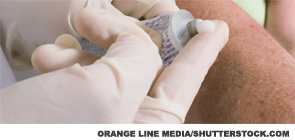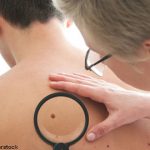
Rheumatologists are sometimes uncomfortable treating skin disease in their patients—but there’s inevitably a clinical situation in which a patient presents with a rash, and you think that a short course of topical steroids might help. You may be certain the rash is related to the patient’s condition or medications used for that condition, be it psoriasis, psoriatic arthritis, cutaneous lupus or dermatomyositis.
For example, when treating psoriatic arthritis, “Although systemic treatments can work in the skin, it’s not uncommon to have residual skin disease,” says dermatologist and rheumatologist Joseph F. Merola, MD, Brigham and Women’s Hospital, Harvard Medical School, Boston. “It’s great if the rheumatologist has some level of comfort with the appropriate use of topical steroids,” says Dr. Merola, who has instructed on the topic.
Perhaps the dermatologists in your area are extremely busy, or the patient does not want to be shuttled to different specialists. Or perhaps you want to offer the patient some relief while they wait to be seen by a local dermatologist.
Here’s some guidance on what to prescribe, possible side effects and when you should leave the diagnosis and treatment to a dermatologist.
What to Use
Topical corticosteroids range in potency from 1 to 7. Over-the-counter topicals have a potency of 7, at the lowest possible range. The highest potency topicals have a 1 ranking.
Rheumatologists should get to know one mild, one moderate and one potent topical treatment, Dr. Merola advises. One online resource that may help is the Topical Steroids Potency Chart, published by the National Psoriasis Foundation.
There are three specific steroids that dermatologist Ellen Frankel, MD, Rejuviderm MediSpa, Cranston, R.I., feels comfortable with nondermatologists prescribing: desonide (class 6), triamcinolone (class 4) or a short burst of clobetasol, which is a more potent therapy (class 1). A report in the January 2015 issue of Dermatologic Clinics focusing on topical therapies for psoriasis reported that clobetasol spray allows patients to apply steroids in areas that may be difficult to reach and may be more potent than the ointment formulation.1 Additionally, clobetasol propionate and betamethasone valerate in foam formulations dry rapidly, with little residue left on the skin.1
Topical steroids range in formulation from gels to liquids to ointments, the latter being the strongest, says Kate Ross, MD, LA Plastic Surgery and Dermatology, Bradenton, Fla. Each formulation has its advantages, depending on where it is used on the body, greasiness and ease of application, according to a paper on topical corticosteroids coauthored by Dr. Ross.2
However, the dermatologists interviewed for this article would prefer to see rheumatologists stick to the lower potency therapies, due to the possible side effects with the higher potencies. “There are times to use the high potency steroids, but that should be done under the close watch of a dermatologist,” says dermatologist Delphine Lee, MD, PhD, director of translational immunology, Dirks/Dougherty Laboratory for Cancer Research, the John Wayne Cancer Institute at Providence Saint John’s Health Center, Santa Monica, Calif.
“Use the stronger steroids for a shorter period of time, or the less strong ones for longer,” recommends rheumatologist Nathan Wei, MD, The Arthritis Treatment Center, Frederick, Md.
Dr. Wei’s approach will depend on the extent of skin disease. If it’s a psoriatic arthritis patient with significant disease, he will always ask an area dermatologist to help recommend treatment. He also sticks to short durations for any use of a topical steroid on the face.
Rheumatologists should be sure to give a sufficient amount of topical steroid when writing prescriptions, Dr. Merola advised. “I remind people that 20 to 30 grams is around the size of a travel-sized toothpaste. Use that as a reference, and then you can scale up if needed,” he says.
Physicians also have to consider the body surface area of involvement, frequency of use and duration of use in prescribing an adequate amount of steroid. “A safe mantra to teach the patient is to use the topical steroid for two weeks and then take one week off,” Dr. Merola says. “This reduces the risk of skin atrophy.”
Dr. Frankel also prefers a maximum use of two weeks on the body, but a maximum of one week if the use is on the face.
Avoid the use of fluorinated steroids on the face, cautions Dr. Ross. Topicals with fluorination can cause rashes on the face because they are too strong.
Although topical steroids have fewer side effects than their systemic counterparts, there are still a number of cautions to consider, especially as the potency increases. Some side effects include acne, thinning of the skin and redness, Dr. Lee says.
Other risks include cataracts, the formation of new blood vessels, tachyphylaxis (which is a decrease in response to topical corticosteroids when they are used constantly), Cushing’s syndrome, stretch marks, steroid rosacea, warts, viral infections and increased susceptibility to skin infections, Dr. Frankel says. And if a topical steroid is unintentionally used in an area with skin cancer, that could delay diagnosis, Dr. Frankel adds.
When to Refer
Even though some rheumatologists are comfortable with the use of topical steroids, dermatologists say there should be no hesitation to give a referral. It’s possible that what appears to be a simple rash could be something else entirely.
It’s also possible that a skin issue may require treatment with something other than a topical steroid. If a condition is not improving after a reasonable treatment period with a topical steroid, that should be cause for a referral.
Another good touch point for referral is if the treatment you recommended has not helped over a two-week period.
“If you have any questions about the diagnosis, it’s best to have a dermatologist on board,” Dr. Lee says.
Find a dermatologist with whom you can work regularly and who will respond readily to questions you may have, she recommends.
In turn, dermatologists will often ask about signs and symptoms of rheumatologic disease, including joint pain, in patients with certain kinds of skin conditions and will refer them to rheumatologists if an inflammatory condition is suspected but undiagnosed, Dr. Ross says. “I always ask about joint pain for that reason,” Dr. Ross says. the rheumatologist
Vanessa Caceres is a medical writer in Bradenton, Fla.


